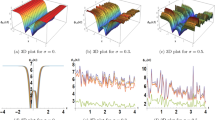Abstract
In this paper, we study the delayed reaction–diffusion Schnakenberg systems with Neumann boundary conditions. Sufficient and necessary conditions for the occurrence of Turing instability are obtained, and the existence of Turing, Hopf and Turing–Hopf bifurcation for the model are also established. Furthermore, for Turing–Hopf bifurcation, the explicit formula of the truncated normal form up to third order is derived. With the aid of these formulas, we determine the regions on two parameters plane, on which a pair of stable spatially inhomogeneous steady states and a pair of stable spatially inhomogeneous periodic solutions exist, respectively. The theoretical results not only reveals the joint effect of diffusion and delay on the patterns that the model can exhibit, but also explain the phenomenon that time delay may induce a failure of Turing instability, found by Gaffney and Monk (Bull Math Biol 68(1):99–130, 2006).










Similar content being viewed by others
References
An, Q., Jiang, W.: Spatiotemporal attractors generated by the Turing-Hopf bifurcation in a time-delayed reaction-diffusion system. Discrete Contin. Dyn. Syst. Ser. B (2018). https://doi.org/10.3934/dcdsb.2018183
Baurmann, M., Gross, T., Feudel, U.: Instabilities in spatially extended predator-prey systems: Spatio-temporal patterns in the neighborhood of Turing-Hopf bifurcations. J. Theret. Biol. 245, 220–229 (2007)
Chen, S., Yu, J.: Stability analysis of a reaction–diffusion equation with spatiotemporal delay and Dirichlet boundary condition. J. Dynam. Differ. Equ. 28(3–4), 857–866 (2016)
Faria, T., Magalhaes, L.: Normal forms for retarded functional differential equations and applications to Bogdanov–Takens singularity. J. Differ. Equ. 122(2), 201–224 (1995)
Faria, T., Magalhaes, L.: Normal forms for retarded functional differential equations with parameters and applications to Hopf bifurcation. J. Differ. Equ. 122(2), 181–200 (1995)
Gaffney, E., Monk, N.: Gene expression time delays and Turing pattern formation systems. Bull. Math. Biol. 68(1), 99–130 (2006)
Guckenheimer, J., Holmes, P.: Nonlinear Oscillations, Dynamical Systems, and Bifurcations of Vector Fields. Springer-Verlag, Berlin (1983)
Guo, S.: Stability and bifurcation in a reaction–diffusion model with nonlocal delay effect. J. Differ. Equ. 259(4), 1409–1448 (2015)
Guo, S., Ma, L.: Stability and bifurcation in a delayed reaction–diffusion equation with Dirichlet boundary condition. J. Nonlinear Sci. 26(2), 545–580 (2016)
Gurdon, J., Bourillot, P.: Morphogen gradient interpretation. Nature 413(6858), 797–803 (2001)
Hadeler, K., Ruan, S.: Interaction of diffusion and delay. Discrete Contin. Dyn. Syst. Ser. B 8(1), 95–105 (2012)
Jang, J., Ni, W., Tang, M.: Global bifurcation and structure of Turing patterns in the 1-d Lengyel–Epstein model. J. Dynam. Differ. Equ. 16(2), 297–320 (2004)
Jiang, W., Anm Q., Shi, J.: Formulation of the normal forms of Turing-Hopf bifurcation in reaction–diffusion systems with time delay. arXiv:1802.10286 (2018)
Just, W., Bose, M., Bose, S., Engel, H., Schöll, E.: Spatiotemporal dynamics near a supercritical Turing–Hopf bifurcation in a two-dimensional reaction-diffusion system. Phys. Rev. E 64(2), 026219 (2001)
Kidachi, H.: On mode interactions in reaction diffusion equation with nearly degenerate bifurcations. Prog. Theor. Phys. 63(4), 1152–1169 (1980)
Kuznetsov, Y.A.: Elements of Applied Bifurcation Theory. Springer-Verlag, Berlin (1995)
Lee, S., Gaffaney, E., Baker, R.: The dynamics of Turing patterns for morphogen-regulated growing domains with cellular response delays. Bull. Math. Biol. 73, 2527–2551 (2011)
Li, X., Jiang, W., Shi, J.: Hopf bifurcation and Turing instability in the reaction-diffusion Holling–Tanner predator–prey model. IMA J. Appl. Math. 78(2), 287–306 (2013)
Liu, P., Shi, J., Wang, Y., Feng, X.: Bifurcation analysis of reaction–diffusion Schnakenberg model. J. Math. Chem. 51(8), 2001–2019 (2013)
Maini, P., Painter, K., Chau, H.: Spatial pattern formation in chemical and biological systems. J. Chem. Soc. Faraday Trans. 93(20), 3601–3610 (1997)
Meixner, M., Dewit, A., Bose, S., Scholl, E.: Generic spatiotemporal dynamics near codimension-two Turing–Hopf bifurcations. Phy. Rev. E 55(6), 6690–6697 (1997)
Murray, J.: Mathematical Biology. Springer, New York (2003)
Ni, W., Tang, M.: Turing patterns in the Lengyel–Epstein system for the CIMA reaction. Trans. Am. Math. Soc. 357(10), 3953–3969 (2005)
Peng, R., Yi, F., Zhao, X.: Spatiotemporal patterns in a reaction–diffusion model with the Degn–Harrison reaction scheme. J. Differ. Equ. 254(6), 2465–2498 (2013)
Ricard, M., Mischler, S.: Turing instabilities at Hopf bifurcation. J. Nonlinear Sci. 19(5), 467–496 (2009)
Schnakenberg, J.: Simple chemical reaction systems with limit cycle behaviour. J. Theor. Biol. 81(3), 389 (1979)
Shi, H., Ruan, S.: Spatial, temporal and spatiotemporal patterns of diffusive predator–prey models with mutual interference. IMA J. Appl. Math. 80(5), 1534–1568 (2015)
Song, Y., Jiang, H., Liu, Q., Yuan, Y.: Spatiotemporal dynamics of the diffusive Mussel–Algae model near Turing–Hopf bifurcation. SIAM J, Appl Dyn. Syst. 16(4), 2030–2062 (2017)
Su, Y., Wei, J., Shi, J.: Hopf bifurcations in a reaction-diffusion population model with delay effect. J. Differ. Equ. 247(4), 1156–1184 (2009)
Turing, A.: The chemical basis of morphogenesis. Philos. Trans. R. Soc. Lond. Ser. B 237(641), 37–72 (1952)
Wang, J.: Spatiotemporal patterns of a homogeneous diffusive predator–prey system with Holling type III functional response. J. Dyn. Differ. Equ. 29, 1–27 (2016)
Ward, M., Wei, J.: The existence and stability of asymmetric spike patterns for the Schnakenberg model. Stud. Appl. Math. 109(3), 229–264 (2002)
Wittenberg, R., Holmes, P.: The limited effectiveness of normal forms: a critical review and extension of local bifurcation studies of the Brusselator PDE. Physica D 100(1–2), 1–40 (1997)
Xu, C., Wei, J.: Hopf bifurcation analaysis in a one-dimensional Schnakenberg reaction–diffusion model. Nonlinear Anal. RWA 13, 1961–1977 (2012)
Yan, X., Li, W.: Stability of bifurcating periodic solutions in a delayed reaction-diffusion population model. Nonlinearity 23(6), 1413 (2010)
Yi, F., Gaffney, E., Seirin, L.: The bifurcation analysis of Turing pattern formation induced by delay and diffusion in the Schnakenberg system. Discrete Contin. Dyn. Syst. Ser. B 22(2), 647–668 (2017)
Yi, F., Wei, J., Shi, J.: Bifurcation and spatiotemporal patterns in a homogeneous diffusive predator–prey system. J. Differ. Equ. 246(5), 1944–1977 (2009)
Acknowledgements
The work was supported in part by the National Natural Science Foundation of China (Nos. 11871176, 11671110).
Author information
Authors and Affiliations
Corresponding author
Rights and permissions
About this article
Cite this article
Jiang, W., Wang, H. & Cao, X. Turing Instability and Turing–Hopf Bifurcation in Diffusive Schnakenberg Systems with Gene Expression Time Delay. J Dyn Diff Equat 31, 2223–2247 (2019). https://doi.org/10.1007/s10884-018-9702-y
Received:
Revised:
Published:
Issue Date:
DOI: https://doi.org/10.1007/s10884-018-9702-y




